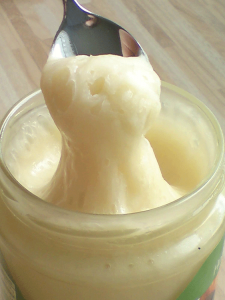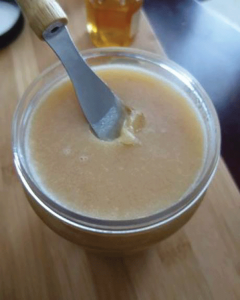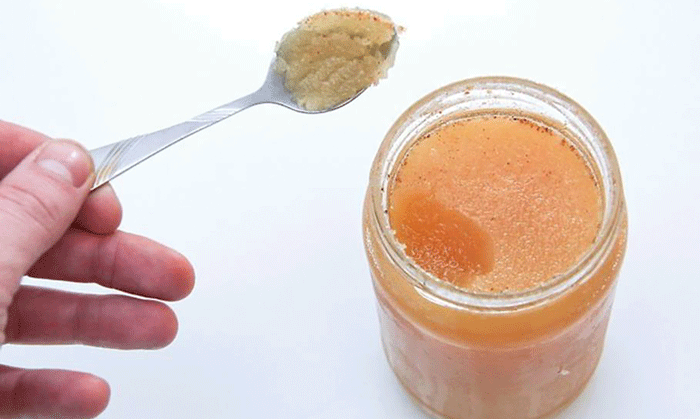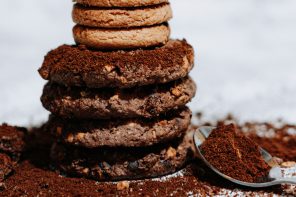By: Howard Scott
Make more money. Work less.
In the market shelf these days, I see more and more cremed and crystallized honey. There is Really Raw Honey, the Baltimore, MD packer that only sells unprocessed, unstrained honey. In addition, many stores offer local offerings of the solid variety. In fact, the solid product is often sold at a premium price. Such a market trend should get you thinking about converting your customers to cremed honey.
Cremed honey is simply liquid honey that has crystallized, almost all honeys do, but the size of the resulting crystals are controlled so the honey is smooth as ice cream. Some honeys crystallize this way naturally, some form large, course crystals.
 After all, selling cremed (or solid) would certainly make life easier, save time, and reduce monitoring effort. Cremed honey is the natural state, or at least its ultimate composition. It would be easier to stock one item rather than two. Moreover, liquid honey that is turning looks bad. Floating particles combined with hulking stalactites festooned to the edges gives the product an eerie look. Partially crystallized honey looks dirty, as if the beekeeper didn’t care about his product. With cremed honey, one wouldn’t have to worry about such appearance. Furthermore, a seller of cremed honey doesn’t have to worry about bottles going bad over the Winter. Finally, the less one heats honey, the more healthful it is. Here, then, is how you might try to convert your customers to cremed honey. Even converting a portion of them will make your life easier. Read: you’ll make more money.
After all, selling cremed (or solid) would certainly make life easier, save time, and reduce monitoring effort. Cremed honey is the natural state, or at least its ultimate composition. It would be easier to stock one item rather than two. Moreover, liquid honey that is turning looks bad. Floating particles combined with hulking stalactites festooned to the edges gives the product an eerie look. Partially crystallized honey looks dirty, as if the beekeeper didn’t care about his product. With cremed honey, one wouldn’t have to worry about such appearance. Furthermore, a seller of cremed honey doesn’t have to worry about bottles going bad over the Winter. Finally, the less one heats honey, the more healthful it is. Here, then, is how you might try to convert your customers to cremed honey. Even converting a portion of them will make your life easier. Read: you’ll make more money.
•The presentation. Hold both containers and ask which the customer prefers. Perhaps hold the cremed bottle farther out, closer to the buyer’s hand. The customer might ask, “Which do you prefer?” You state that it doesn’t make any difference, that it is a matter of taste. You might want to go into why cremed honey is a more natural state. Furthermore, you point out that it is easier and less messy to spread on toast. As far as using in liquids, it dissolves just as rapidly as liquid honey. Finally, you go into why you enjoy the crunchy taste of solid honey.
•The personal solicitation. You state that you prefer cremed honey, and state your reasons. But go into them with more detail. What I do is talk about the less messiness. I might say this: “Every morning, I lather honey on toast. In the old days, my fingers would get so gunked up that I needed half a dozen napkins and had to wash my hands at least twice every meal. Now, cremed honey smoothly spreads on toast. It never drips or spreads. There’s never any sticky spots on the floor and traipsing through the house creating smudges. I eat the toast in one sitting, use one napkin, then I wash my hands. It is so much easier. Plus, I prefer the taste of those granules. I get both the taste of aromatic honey, with the texture of crunchy peanut butter.”
•The combination offer. When someone wants four or 10 jars, offer one cremed and three liquid or two cremed and eight liquid. When the customer asks about the different offering, go into your arguments. Cater your answer to what you think the customer wants to hear. For example, if you know the customer is a health nut, emphasize that cremed version has its essential healthy properties intact, that is, the enzymes that the honey bees deposited in the nectar are still there, and still radiating health and vigor. If you thought the customer enjoyed the taste, suggest that she should try the same item in a different form.
I have half a dozen regular customers that order six to 10 jars at a time. To date, I have converted half of them to the cremed variety by the above approach. Getting someone to try the new item is half the battle. As far as storing both varieties, it’s no problem. I maintain containers of both varieties. So it’s not really carrying two product lines.
•The natural process argument. All honey granulates. This is a fact of life. I point out that cremed honey is the more natural state, because that is the composition it becomes. This argument often gets the customer to try the product. “Natural” seems to ring somewhere in their consciousness. Somehow the designation confers more legitimacy onto the product and less of a step child. Make the argument that honey sitting in cupboards naturally tends to granulate and excessive heating is bad for the product. I point out that such heating could destroy the health-inducing enzymes of honey. So if you have to re-heat the product two or three times, you could lose some benefit. That argument gets me into trouble because the customer comes at me with pin-point logic: “You mean you kill all the healthy enzymes whenever you liquefy honey? Then, if your local honey isn’t better for you, I might as well buy supermarket product, and pocket the extra $5 I would have spent.” Of course, I point out that we don’t heat to above 100°, while supermarket variety is batched at 160 degrees.
•The price advantage. I offer a slightly lower price for cremed honey. Currently, I sell my liquid honey for $11.00 and my cremed honey for $10.00.
It is only a dollar difference, but that savings motivates many buyers. The justification I offer is that cremed honey takes less effort, less maintenance, and therefore can be had cheaper. Holding up both items, I say, “This one is $11.00 and this one is $10.00.” You’d be surprised how many people are motivated by the lower-priced offering
“But they taste different, right?” A customer might ask.
“No, they’re both honey,” I respond. “The cremed is more solid, grainier. The liquid goes down smooth. But it’s all the same product.”
•The visual pitch. Many prefer the liquid variety because of its purity and clearness. So one must emphasize the interesting visual properties of cremed honey. Call it romanticizing the chunky. I might offer something like the following: “Look at this bottle. It looks like an ancient cave, with hieroglyphics written all over the walls. What does it call to mind? If you say ancient civilizations, of the myriad paths of history, of how the foundations of our modern world stack up upon each other, I would agree. Of course, honey played a part in this past. Just to point up one example, kings were mummified in honey in early Egyptian civilizations.”
•The store buyer approach. To the merchant, you might argue that cremed honey never alters its appearance unlike its brethren which starts to de-liquefy the minute it is put on the store shelf. Bring the merchant over to the honey shelf (that you have checked before), and point out several bottles of mottled liquidity. Suggest that no customer would buy that product. Of course, all suppliers are supposed to monitor this hardening, but often they don’t get around to replacing every bottle that begins to granulate. Carrying a significant percentage of cremed honey eliminates that problem.
 Personally, I only use cremed honey. Furthermore, I believe that all these arguments offered above are valid. The grainy texture melts soothingly on my tongue. I enjoy licking the knife of its globule chunks. There is nothing quite as delectable as crisp toast covered with marshmallow fluff and a generous lathering of cremed honey. I hold my peanut butter and honey sandwich confidently, knowing that drips won’t fall on my lap. Then, after supper when those dessert sirens work their alluring magic, I dollop several tablespoons of cremed honey over ice cream, and enjoy the transformative experience of tasty crunch with icy dark chocolate. Yum, yum! I like it that my hands never ooze with stickiness. I smile at the thought that my wife will never command me to re-liquefy. And, yes, I peruse every jar of cremed honey, trying to decipher what the fissures and crags mean.
Personally, I only use cremed honey. Furthermore, I believe that all these arguments offered above are valid. The grainy texture melts soothingly on my tongue. I enjoy licking the knife of its globule chunks. There is nothing quite as delectable as crisp toast covered with marshmallow fluff and a generous lathering of cremed honey. I hold my peanut butter and honey sandwich confidently, knowing that drips won’t fall on my lap. Then, after supper when those dessert sirens work their alluring magic, I dollop several tablespoons of cremed honey over ice cream, and enjoy the transformative experience of tasty crunch with icy dark chocolate. Yum, yum! I like it that my hands never ooze with stickiness. I smile at the thought that my wife will never command me to re-liquefy. And, yes, I peruse every jar of cremed honey, trying to decipher what the fissures and crags mean.
But I have had my failures. I periodically suggest to my club (Plymouth County Beekeepers) that we offer cremed honey at our annual 10-day fair. I argue that carrying cremed honey would only increase our variety of offerings. Members heartily veto this suggestion. Their main argument is that solid honey somehow suggests beekeeper failure. I couldn’t disagree more, but I realize that old habits die hard. I believe that, behind my back, I am known as the king of solid honey.
Offering cremed or granulated honey could be your way of reducing selling effort and not incidentally, through saving time, making more money.
CONVERTING LIQUID TO CREMED HONEY:
- Heat honey until fully liquefied.
- Cool rapidly.
- Add 10% starter of crystallized honey and mix. The finer the crystals are that you add, the finer, and smoother the final product will be.
- Cool
- To make very smooth cremed honey, add 10% from a jar made of very fine crystals. To make course and grainy crystallized honey simply use honey from a naturally crystallized jar of honey with course and grainy crystals.
- Wait eight days until fully cremed, and crystallized.
Scott is a 35-year beekeeper. The Pembroke, MA practitioner is the author of the best-selling BEE LESSONS. Contact him at dancinghill@gmail.com.









